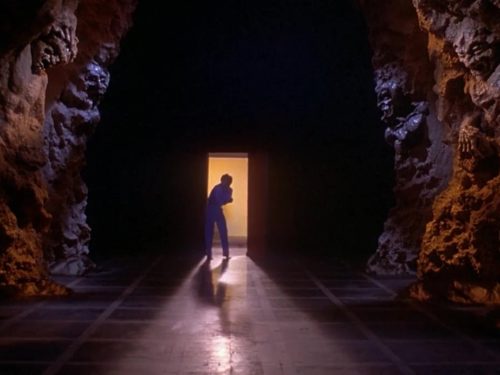Premiering 10 years after his creative breakthrough with Quietly on By (2005), Bloomin Mud Shuffle is, as of this writing, Frank V. Ross’ most recent feature. Coming at the end of a masterful six-film streak, Bloomin also holds the distinction of being the first Ross production to secure professional distribution. Considering how long Ross’ work had garnered critical acclaim but struggled to reach wider audiences beyond the festival circuit, its release by Factory 25 in 2017 was a more-than-welcome, and deserved, development.
With over half a decade passing since Frank V. Ross has made a film, viewers who have followed his career may feel a retrospective tinge throughout Bloomin Mud Shuffle. Shot around his usual stomping grounds in the suburbs of Chicago, we see Ross use many familiar locations, some identifiable from his earliest productions when he was just out of high school. He returns to his mother’s house — which he hadn’t used since transforming its garage into the “dart bar” in Audrey the Trainwreck (2010) — framing views into the kitchen that appear to be quoting from earlier scenes set there in Quietly on By. A crucial scene involves a character rushing to the Westmont train station, whose tracks and sounds have not only appeared in most of his films, but influenced Ross since his youth, when he could hear the arrival whistles from his bedroom window. Bloomin also assembles a cast from across his entire career, including regulars like Allison Latta, Rebecca Spence and Kurt Naebig, as well as Julie Rogers-Baker, who hadn’t appeared in a Ross film since 2003’s Oh! My Dear Desire. And while the credits are filled with his most important and frequent collaborators — Joe Swanberg as a producer and actor, Tiger Tail in Blue (2012) cinematographer Mike Gibisser and composer John Medeski — there are also new additions, including Ross’ highest profile cast to date, with established film and television stars like James Ransone (It Chapter Two, The Wire), Natasha Lyonne (Russian Doll, Orange is the New Black) and Alex Karpovsky (Girls, Beeswax) in major roles.
The film follows house painter Lonnie (Ransone) through a short-lived relationship with a younger co-worker named Monica (Alexia Rasmussen). Lonnie is in a bit of a rut. He’s stuck at a dead end job, and from what we see, he kills a lot of time alone playing video games or at his local bar. Lonnie has a tendency to drink himself to sleep most nights, and he isn’t a stranger to showing up hungover for work. While being extremely personable, Lonnie often appears slightly out of it in many of his social encounters. His romance with Monica is far from easy to maintain as they each lead incredibly different lifestyles. He is unashamedly romantic and direct with his feelings for her, which at times sends her withdrawing from his affection. Yet she sparks something in him, and Lonnie pursues her with an attention that is absent from much of his life.
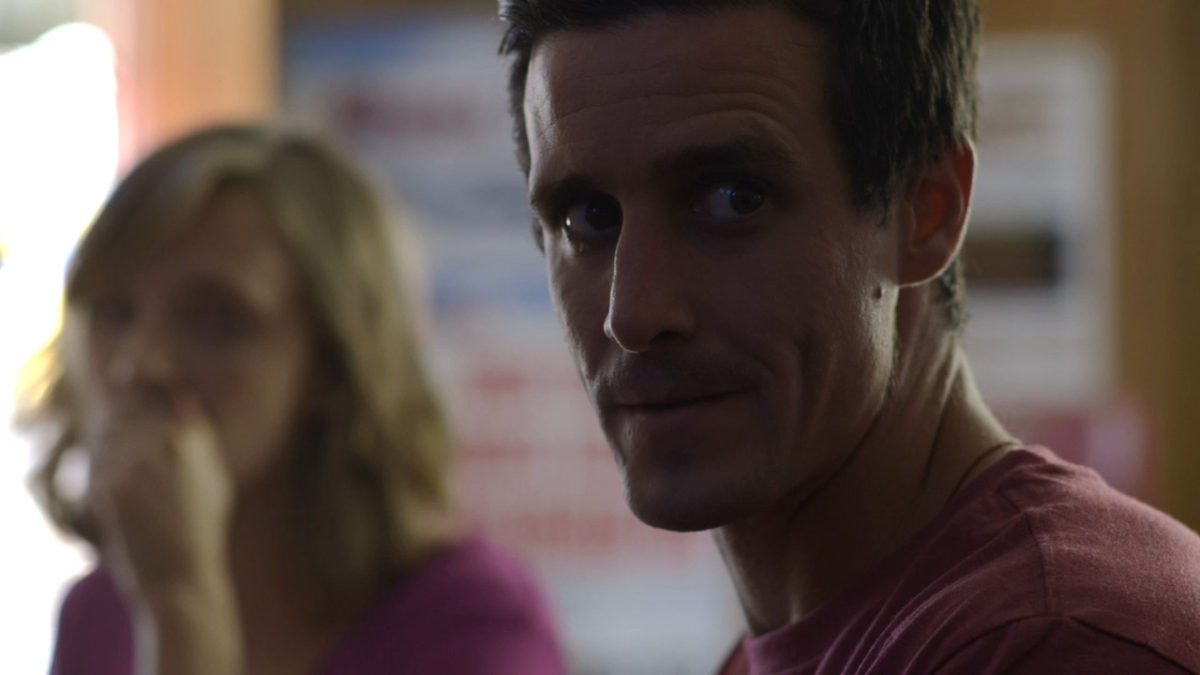
Unlike so many cases of independent filmmakers who move into even slightly higher profile projects and feel pressure to adopt more traditional storytelling methods or crowd-pleasing “indie” formulas, Bloomin Mud Shuffle finds Ross — whose previous films have featured 50-minute prologues within 80-minute runtimes (Tiger Tail in Blue) and a first act that essentially has three opening title sequences (Audrey the Trainwreck) — continuing to experiment with narrative and sequencing. Bloomin progresses in an elliptical manner that may feel jumbled on first viewing. Lonnie will enter his front door, screwing in a lightbulb on his way into the kitchen before the scene will jump cut back to his entryway with Lonnie screwing in the bulb again with Monica at his side; A tender moment between Lonnie and Monica will seamlessly transition into a frantic, blame-casting argument. Ross structures the film so that we see their relationship taking place, in a sense, all at once. Scenes pile up and bounce off of each other, rather than taking rigid cause and effect order; the good times and the bad are loosened from the confines of strict chronology. The film keeps our perspective from solidifying through a basic narrative progression. It guides attention away from who did what and whether Lonnie or Monica made the relationship-ending move, and into the particularities of each individual interaction.
Ross undercuts our ability to judge his characters with this narrative arrangement. He leads us into easy assumptions about their personalities from the very first scene, as Lonnie makes a spectacle of himself in public on a drunken night out. He curses at jaywalking strangers and drags a traffic sign into a bar. This is immediately followed by our introduction to Monica as she silently finishes a morning run. Lonnie is established as crude and rowdy, while Monica comes across as composed and responsible. But before we know it, Ross has guided his narrative in a circle, taking us through the events that led to the opening scene, reworking and complicating our first impressions in the process.
The characters in Bloomin Mud Shuffle are complex creations who we rarely see taking time to reflect upon their lives. Their days are busy, and they seek various forms of diversion in their free time — some healthy, some not. Lonnie can barely catch his temporal or imaginative footing throughout the film as he navigates his days under an alcohol-induced fog. Bloomin grants us a perspective that stretches beyond the limited scope of its characters, but we are given a similarly dense experience to work through in its structure. As in previous Ross films, we are thrown right into the thick of the characters’ daily grinds with them. Bloomin moves at a swift pace, which creates the sensation of time rushing by. Ross includes moments that disrupt the forward momentum and that shock Lonnie into a recognition of his foggy perspective. We see this when he is suddenly struck silent at work upon learning 16 years have passed since he and friend Chuck (Karpovsky) graduated from high school. He can barely begin to fathom where the time went before forcing the thought out of mind.
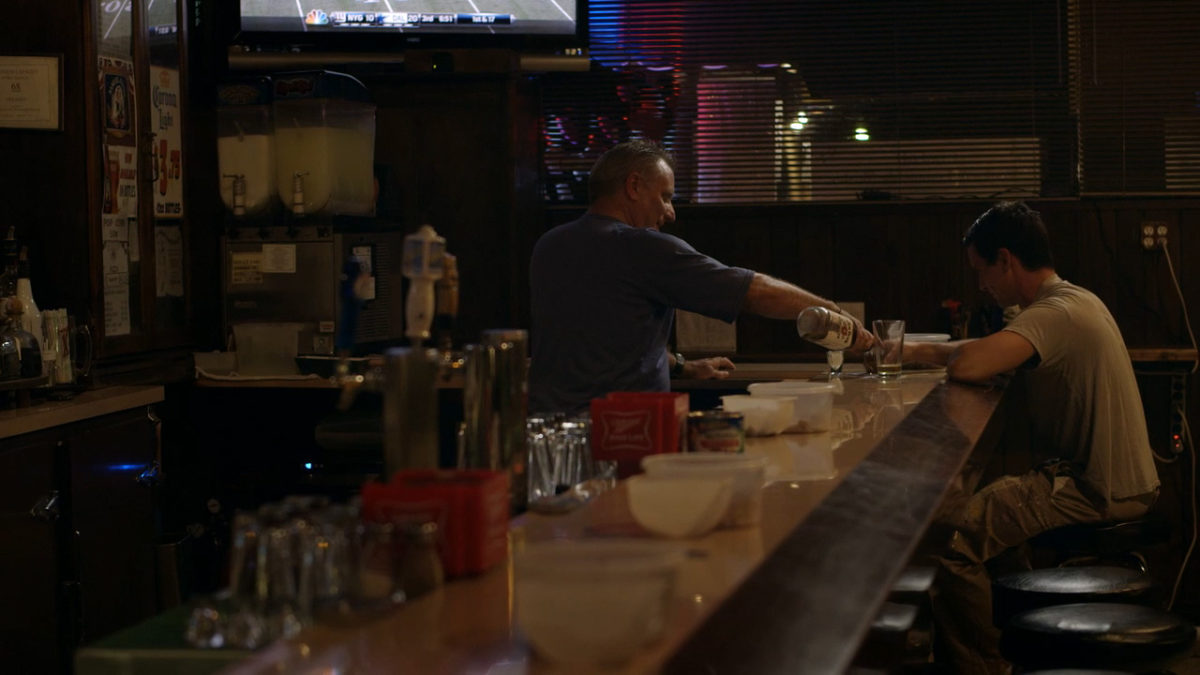
It is harder for Lonnie to distance himself from such thoughts during a skeet shooting trip with friends. Ross builds the scene with Lonnie listening in to the group’s conversations through ear plugs while preoccupied with loading and launching the skeet thrower. With his attention split and hearing blocked, he is immediately placed at a disadvantage in the social aspect of the scene. Lonnie makes a strange joke about having suicidal thoughts in response to a news story being discussed, which initiates a cryptic comment about a mutual acquaintance who took his own life. Lonnie is caught off guard. He somehow never heard about the incident. At this point, Ross buries Lonnie in overlapping dialogue from his three friends as they try to recall when and how it happened. Lonnie’s struggle to catch all the details is heightened by the presence of the shooter, who becomes frustrated as Lonnie fails to operate the skeet thrower fast enough. Like Lonnie, we have to work to catch the various layers in the scene with the dialogue and action taking place all at once, which includes glances and innuendos from Lonnie’s friends who appear to recognize similarities between Lonnie and their recently deceased acquaintance.
While Lonnie is clearly aware changes need to be made in his life, Bloomin avoids the narrative moves that would make the film about Lonnie solving his personal problems. Even after he divulges about his drinking and how lonely he is in a confession booth late in the film, we are not given the impression that he has turned a corner or that he has necessarily gained a greater understanding of his problems. Instead, the most crucial meanings being made take place beyond the characters’ own comprehension. It should be noted that the title Bloomin Mud Shuffle is an expression Ross uses to mean “same shit, different day,” suggesting all the repetitiveness, the frustrations and the feelings of inescapability that come wrapped up in the average work week. By avoiding the usual crescendos of life-altering crises and problem-solving that most films are built around, Ross creates drama in the space where things haven’t coalesced into clearly defined goals or problems for his characters to reach or solve. Their messy, unarticulated emotions and frustrations are stuck clashing against daily processes and routines. They might recognize something in their life needs to change, but Ross is more interested in the way they carry it with them, pressing on through their days and putting off the conflict.
Following early scenes of Lonnie and Monica mostly hitting it off together, we see a minor argument take place when Lonnie questions where their relationship stands. He asks whether he will ever be the kind of guy Monica invites over for Sunday dinner. She tells him she isn’t ready for that. Ross then splits each of them off into respective Sunday meals with their families in Bloomin’s masterful centerpiece sequence. Cross-cutting between their separate gatherings, we see them in more familiar environments, relaxing into their personalities in ways they wouldn’t necessarily allow while trying to impress each other. Lonnie’s cheesesteak meal with his father (Jim Saltouros) and sister, Jock (Lyonne), displays a boisterous and confrontational form of love. Their discussion is jovial and uninhibited, ranging from crude jokes about each other’s sex lives to Lonnie’s sincere detailing of how much he adores Monica. They are open to express themselves, but no one is off-limits from becoming the butt of the family’s jokes. This unrestrained style easily flips from quick-witted banter to its opposite extreme. When a passionate screaming match erupts between Jock and her father over a medical bill for a biopsy he had tried to hide from them, the scene explodes, ending with Lonnie having to out-yell the others to bring tempers down.
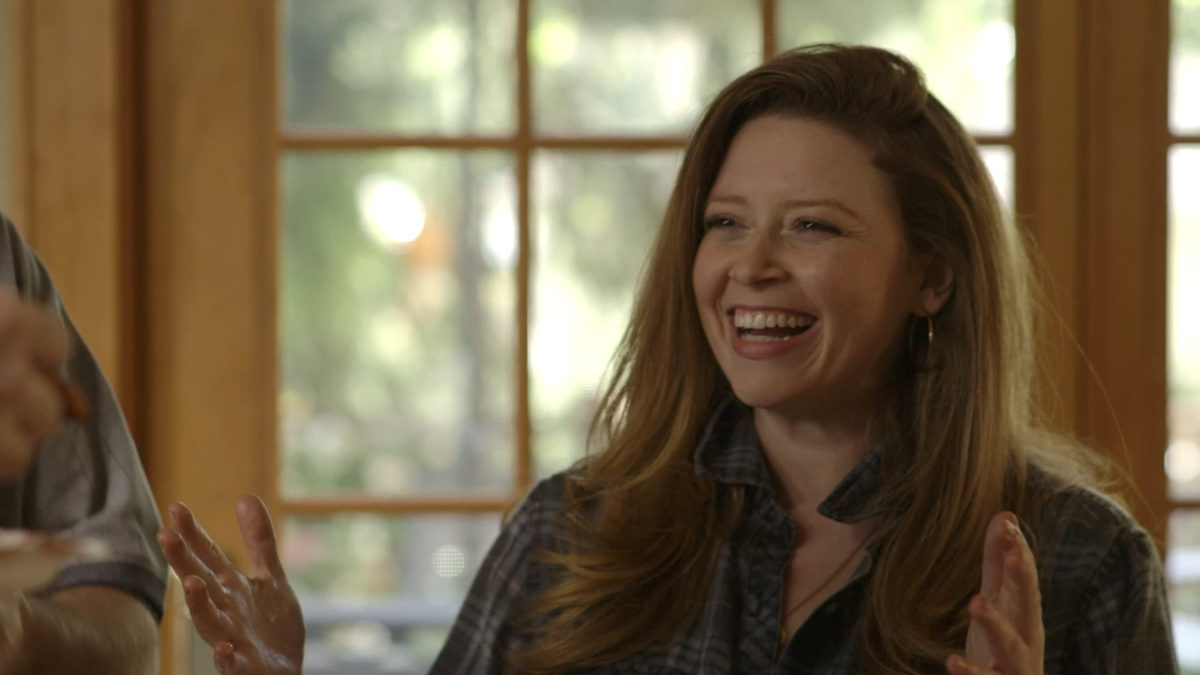
The scene at Monica’s gives us an entirely different dynamic. It is a much bigger gathering, with Ross breaking characters off into smaller groups and pairings throughout the house. The conversations are much more reflective and mild-mannered. The older adults swap stories about deceased relatives and old family recipes. Monica’s little brother quietly shares discoveries on his cellphone with an uncle or cousin. As a group of women prep food in the kitchen, Monica is present only in body as she texts on her phone at the table. Her family tries to draw her into a conversation about her dating life, which she avoids with sarcastic comments, her attention never entirely leaving the glow of her phone. The other women joke as Monica fades from their conversation, but they ultimately let her check out.
The interplay between the rambunctiousness of Lonnie’s family and the more reserved and reflective atmosphere at Monica’s gathering allows Ross to use various mirroring devices to draw crucial contrasts between his characters’ personalities. Ross doubles scenarios across the two scenes. Lonnie and Monica both field questions about their love lives, and the way humor comes into play in these interactions speaks multitudes. For Lonnie, his family’s questions come in a joking and mostly crude sparring manner, which Lonnie responds to with openness about his feelings for Monica. The jabs and insults being hurled back-and-forth are understood as signs of affection. For Monica, her sense of humor acts more like a shield against touching on personal subjects with her relatives. The personal is something she avoids bringing out into the open for discourse, using curt jokes to draw the subject to an ambiguous close. Ross then ends both scenes with the daughters leaving first. For Monica, it is entirely verbal. She announces from a distance to her napping father that she is ready to go and leaves the room before he can shake himself from his post-meal slumber. Jock’s farewell takes place as a loving physical assault on her male loved ones. She walks into the room and smacks, slaps, squashes and curses Lonnie and her father, who both weather the torment with smiles and laughs from the couch.
Elements of what we see established in these mirrored family encounters bleed into our understanding of scenes between Lonnie and Monica. What Ross shows us in the interactions between Lonnie’s family is not only the source of so much of Lonnie’s humor — his father makes jokes that we hear Lonnie repeat for Monica — but also his temperamental side. While passionate, caring and eager for connection, Lonnie often loses control of his excitability. We see how it can turn against him and lead him into starting fights at sports bars and overwhelming Monica with his expressions of love for her. Monica’s initial attitude towards Lonnie shows her taking a more mature role in their interactions. Yet, as she does with her family, we see throughout the film how her composure can lead to shutting out the world and those around her.
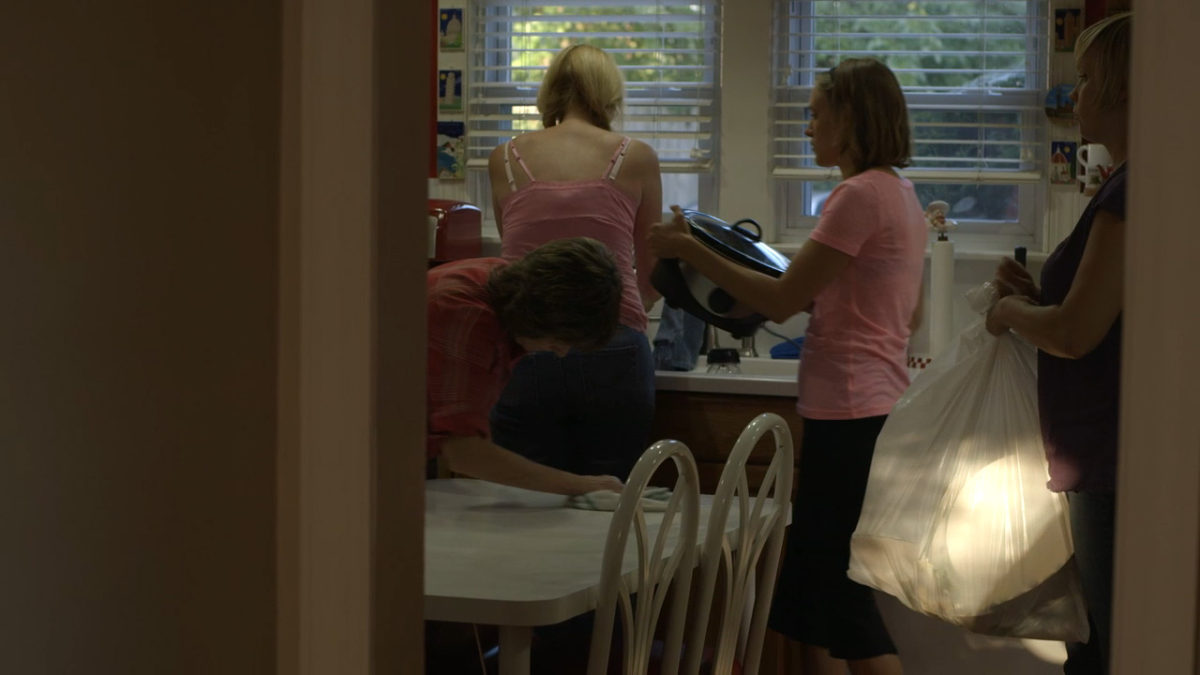
After his relationship with Monica fizzles away, the priest (David Pasquesi) Lonnie visits tells him to look around more and take opportunities for connection as they arise naturally. The priest’s basic, yet sincerely delivered advice holds a notable weight within Ross’ filmography. That seemingly simple goal is rarely so easy for characters to put into practice. At their core, the greatest conflicts within Ross narratives are being fought on a perceptual level, often unbeknownst to his characters who are so caught up in the immediacy of their lives. Ross has a rare ability to give form to the tunnel vision that comes from characters following routined ways of living too closely. Some may suspect that they are missing something. They may question where the time goes or why they are so apt to conform to lifestyles that wear them so thin. And for the most part, they go on doing what they’ve always done. In Bloomin, through these scenes of Lonnie drinking his memory away or Monica checking out emotionally or on her phone, we see a greater concern for how his characters seek relief through distractions, but also for how the distractions can become the defining factors of their experience. Ross works this into his narrative design, challenging viewers to see more through their blindness.
The priest’s practical wisdom is far from divinely prophetic for either of Bloomin’s lead characters. Yet the film ends with each of them encountering and accepting opportunities for connections in new ways. Lonnie certainly doesn’t meet “the one” or, as mentioned, immediately change his lifestyle — the first thing we see after his visit to the confession booth is Lonnie smoking a cigarette from his emergency stash. Instead, we see him stop on his way home to help a kid fix his bicycle. Few films could take the simple act of resetting a bike chain and turn it into a climax point. But somehow Ross finds a way for such a minor action to stand for something better beginning within Lonnie: he recognizes hope and change in the smallest of gestures.
****
In this country where so much of success relating to filmmaking is judged superficially — financially or in terms of star power or technical sheen — Frank V. Ross and his films offer a refreshing and inspiring alternative to the usual industrial and commercial ladders. With Ross, we have been able to see something very rare in American narrative filmmaking, particularly among modern independent filmmakers and the “mumblecore” group Ross is so often associated with. Ross is an artist making films on his own terms, who has persevered through the struggles and frustrations of truly independent productions for over a decade to develop his style almost entirely free from the pressures of commercial interference. As the world has repeatedly proven, the best works of art tend to take longer to be recognized, and it makes sense that Ross’ films would take time to garner worthy acclaim. They are so stealthily complex in form and humbly profound in vision. They don’t make things easy on viewers; they provoke us and challenge us to see ourselves in his characters and recognize where our own blindspots and complacencies align with what we see on screen.
Ross has yet to receive the level of attention many of his peers have, some of whom have moved on to studio work and television. But the six films Ross has produced since 2005 are not only the evidence of an independent artist flying under the commercial radar — these films are the culmination of one of the most consistently brilliant streaks in modern American filmmaking. Period. Since Bloomin Mud Shuffle’s quiet digital release by Factory 25, Ross has made the switch to literature, focusing his attention on a novel. It is too soon to make such distinctions, but Bloomin will hopefully come to stand as a threshold point in Ross’ career between his “early films” and the next stage in his film work when he makes his return behind the camera.
Read the entire series of Split Tooth Media Presents: The Films Of Frank V. Ross by Brett Wright
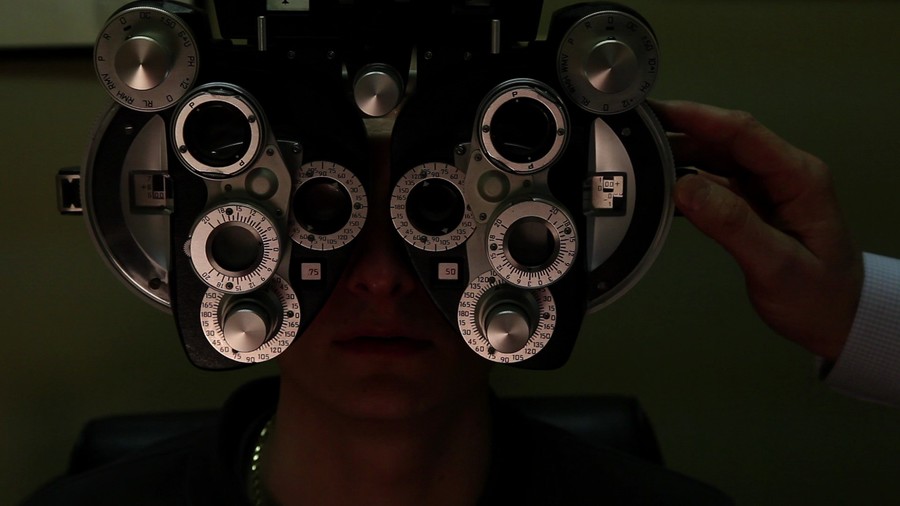
Stream or purchase Bloomin Mud Shuffle on Amazon Prime, Vimeo, Kanopy and Tubi
Purchase physical copies of Ross’ work from his website
Follow Brett on Twitter and Letterboxd
(Split Tooth may earn a commission from purchases made through affiliate links on our site.)




